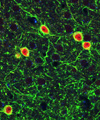May
Study explores development of epilepsy after brain injury

Scientists at Newcastle University will carry out a pioneering study to look at the development of epilepsy following a serious brain injury.
Epilepsy can be triggered after traumatic brain damage such as a stroke, head trauma and some infections, yet no-one knows why some people go on to develop the life-threatening condition and others do not.
A team at Newcastle University has now been awarded more than £147,000 from leading charity, Epilepsy Research UK, to study epileptogenesis – a term used to describe how epilepsy arises after an injury to the brain.
Epileptogenesis involves a long and complex cascade of events, and what little is known about it mainly focuses on the latter stages, as seizures start to occur. Identifying what happens at the beginning, however, could lead to important breakthroughs and, ultimately, treatments to stop the serious condition developing.
The two-year project is being led by Dr Andrew Trevelyan, from Newcastle University’s Institute of Neuroscience, in collaboration with Dr Claudia Racca, Dr Ryley Parrish, and Dr Simon Cockell. It is one of only nine schemes nationwide in 2015 to receive a grant from the charity.
Dr Trevelyan (pictured) said: "We are delighted that Epilepsy Research UK are continuing to support our work. Several years ago they provided me with the fellowship that helped to start my research group at Newcastle University, and which now includes eight people working full-time trying to understand what goes wrong during an epileptic seizure. That work led to key insights into how we identify from where in the brain the seizures arise.
"Now we want to understand how epilepsy might develop after an injury to the brain. This is a huge clinical problem because following such injuries, which include head trauma, strokes and some kinds of infection, there is a high risk of developing epilepsy. But we cannot identify which people are at most risk, and even we could do so, we have no drugs to help them. What we need is the equivalent of the ‘morning after’ pill, to give people who have had a head injury or infection.”
The expert team will focus on the beginning of epileptogenesis, aiming to identify how a brain injury can lead to early changes in neuronal function. The group will use mice brain samples to study how an episode of intense seizure-like activity causes neurons to change which genes they express, which in turn will affect how the neurons behave.
It is believed that these gene expression changes are the start of the epileptogenesis process, and by identifying these changes, we might find new drugs and treatments that can prevent it. The team hopes new therapies will be identified within the next 15 years.
Dr Trevelyan added: "We have developed new research techniques which we believe might shed light on this important clinical process. The main focus will be to understand how different types of neurons respond to the injury. In particular, we believe there may be ‘neuronal martyrs’, cells which put the needs of the brain above their own needs. If they do their job well, then all is well, but if they act selfishly, prioritising their own needs, then it may bring down the whole system, and epilepsy may develop.”
More than 600,000 people nationwide are thought to have epilepsy - around one in every 100 people. Around 70% of these have their seizures controlled with medication, but many others do not, and there are approximately 1,200 epilepsy-related deaths each year.
Epilepsy research is underfunded in the UK so the grant awards made by Epilepsy Research UK significantly increase the pool of research being undertaken into this poorly understood condition. Over the last five years Epilepsy Research UK has provided more than a third of all research funding into better understanding the condition; its diagnosis, treatment and possible cure.
Delphine van der Pauw, Research and Information Manager at Epilepsy Research UK, said: “We are hugely excited about this study and have every faith that Dr Trevelyan and his team will get the very best out of it. We really hope that the knowledge gained will ultimately lead to treatments that prevent epilepsy from developing after a brain injury. That would be a wonderful outcome.”
Just in the last two months (April - May), Dr Trevelyan had papers published in two prestigious journals, Neurology and the

Photo caption: Parvalbumin cells in red (which are the nominal “neuronal martyrs”), with their processes labelled green, and pyramidal cells are seen as shadows. Courtesy of Dr Claudia Racca and Dr Andrew Trevelyan.
published on: 27 May 2015
